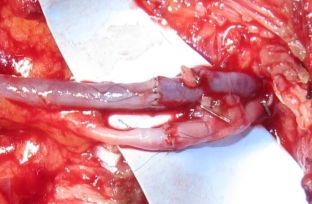The application of vascular sutures is one of the most difficult stages of any surgical intervention in microsurgery. Science does not stand still, and every year new methods and ways are added to medicine to simplify the work of doctors, including microvascular surgeons. Among suture methods of vascular anastomoses, mechanical suture is a relatively new and not very widespread method, which, nevertheless, takes its place in microvascular surgery. Estet-portal.com talks in detail about the features of mechanical sutures, as well as the main advantages and disadvantages of this technique.
Suture machines for mechanical sutures on vessels
The first model of a vascular suture machine was developed in the 1950s by a group of Russian engineers and scientists. To date, such devices are used for the imposition of vascular anastomoses with a diameter of 1 to 4 mm. Suture devices have proven themselves well when creating anastomoses of veins and arteries with thin walls.
The use of mechanical sutures significantly reduces the time of anastomosis, and, consequently, the duration of the operation itself.
At the same time, the suture machine is not completely universal, since it takes some time to set it up and prepare it for work.
Mechanical seam:
- features of using suture machines for mechanical sutures;
- major disadvantages of using mechanical seams;
- invagination method of mechanical suture application.
Peculiarities of using suture machines for mechanical sutures
All modern suture machines are divided into three main types:
- separate circular metal staplers;
- eversion needle ring devices;
- extra-lumen sleeves and cuffs.
When applying a mechanical seam, you should pay attention to such important points:
- To best fit the ends of the vessels to be sutured, different sizes of suture rings should be used;
- stringing the vessel on the needles should be carried out by one surgeon, and holding the vessel coupled on the ring – others;
- it is extremely important to avoid damage to the intima during the process of stringing the vessel;
- Closed rings are removed only after doctors have made sure that the suture device is closed.
The main disadvantages of using mechanical seams
Suture devices have not been widely used in microvascular surgery today, because they have a number of disadvantages associated with the technical complexity of applying mechanical sutures:
- staplers are too large for effective work under the operating microscope;
- The use of needle ring devices should only be performed by surgeons with considerable experience and sufficiently well trained assistants;
- Suturing devices use too much vessel length to achieve sufficient eversion in the anastomosis, and it is very difficult to choose the correct size of the coupler.

Invagination method of mechanical suturing
To date, the most promising method of mechanical suture is the invagination method of vessel connection. The method of applying a mechanical suture in this case involves the use of structures external to the vessel, for example, tubes or rings, with the help of which one end of the vessel is inserted into the other, after which the walls of the vessel are fixed to a solid outer frame. At the same time, the imposition of a microanastomosis in this way takes an average of 4 minutes, and the frequency of postoperative thrombosis in one hundred patients who underwent surgery did not exceed 1.6%, which indicates a real perspective of the invagination method.







Add a comment